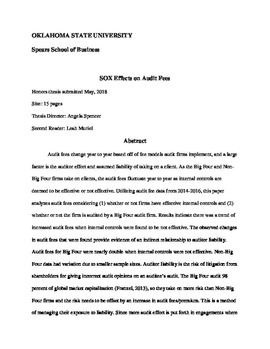| dc.contributor.author | Edwards, Nathaniel | |
| dc.date.accessioned | 2019-02-06T19:54:37Z | |
| dc.date.available | 2019-02-06T19:54:37Z | |
| dc.date.issued | 2018-05-03 | |
| dc.identifier | oksd_edwards_HT_2018 | |
| dc.identifier.uri | https://hdl.handle.net/11244/317128 | |
| dc.description.abstract | Audit fees change year to year based off of fee models audit firms implement, and a large factor is the auditor effort and assumed liability of taking on a client. As the Big Four and Non-Big Four firms take on clients, the audit fees fluctuate year to year as internal controls are deemed to be effective or not effective. Utilizing audit fee data from 2014-2016, this paper analyzes audit fees considering (1) whether or not firms have effective internal controls and (2) whether or not the firm is audited by a Big Four audit firm. Results indicate there was a trend of increased audit fees when internal controls were found to be not effective. The observed changes in audit fees that were found provide evidence of an indirect relationship to auditor liability. Audit fees for Big Four were nearly double when internal controls were not effective. Non-Big Four data had variation due to smaller sample sizes. Auditor liability is the risk of litigation from shareholders for giving incorrect audit opinions on an auditee's audit. The Big Four audit 98 percent of global market capitalization (Franzel, 2013), so they take on more risk than Non-Big Four firms and the risk needs to be offset by an increase in audit fees/premium. This is a method of managing their exposure to liability. Since more audit effort is put forth in engagements where there is litigation risk/auditor liability the increase in fees can be seen as an improvement in quality of audits due to increased audit effort. It is in the best interest of an audit firm to avoid litigation from shareholders, because the damage to market value and reputation can cause irreparable damage. The results from 2014 to 2016 are meant to provide an update to the effects of SOX on audit fees and the connection to auditor liability. This data should provide further evidence of the continuous effects of SOX. | |
| dc.format | application/pdf | |
| dc.language | en_US | |
| dc.rights | Copyright is held by the author who has granted the Oklahoma State University Library the non-exclusive right to share this material in its institutional repository. Contact Digital Library Services at lib-dls@okstate.edu or 405-744-9161 for the permission policy on the use, reproduction or distribution of this material. | |
| dc.title | SOX effects on audit fees | |
| osu.filename | oksd_edwards_HT_2018.pdf | |
| osu.accesstype | Open Access | |
| dc.type.genre | Honors Thesis | |
| dc.type.material | Text | |
| dc.contributor.director | Spencer, Angela | |
| dc.contributor.facultyreader | Muriel, Leah | |
| thesis.degree.discipline | Business | |
| thesis.degree.grantor | Oklahoma State University | |
